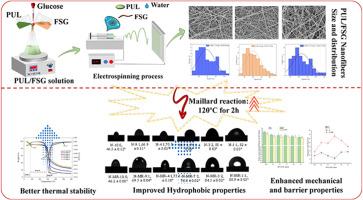美拉德反应改变普鲁兰/鱼皮明胶基静电纺纳米纤维的结构、理化、力学特性和抗菌活性
IF 11
1区 农林科学
Q1 CHEMISTRY, APPLIED
引用次数: 0
摘要
本研究通过美拉德反应(MR),将新型普鲁兰/鱼皮明胶(FSG)静电纺丝纳米纤维交联,以提高其在食品包装中的功能性能。交联指数和x射线光电子能谱(XPS)分析证实交联成功。结果表明,纳米纤维的直径在100 ~ 300 nm之间,具有均匀性,磁共振交联增强了其结构稳定性。傅里叶红外(FTIR)分析表明,糖基化消耗了-NH2基团,裂解了PUL的糖单元,并影响了FSG的二级结构;热重分析(TGA)表明,交联纳米纤维(N- mr)的最大降解温度为315.5°C,而非交联纳米纤维(N)的最大降解温度为308.2°C。经MR反应后,共混物的拉伸强度由3.01 MPa提高到3.59 MPa,由7:3共混物的拉伸强度由1.53 MPa提高到3.84 MPa。水接触角保持在90°以下,MR后从46.2°(10:0)增加到88.9°(1:1),4:1共混物的水蒸气渗透率从5.35 g mm/m2·h·kPa下降到4.71 g mm/m2·h·kPa,而1:1共混物的溶胀率从774.6%下降到693.9%,增强了阻隔性能,这一趋势在所有共混物中都是一致的。抗氧化活性显著增强,总酚含量达到36.14 mg GAE/100g,清除DPPH和ABTS的活性分别达到81.19%和75.10%。磁流变交联纳米纤维还显示出对大肠杆菌和金黄色葡萄球菌的抗菌作用,使其成为可持续活性食品包装的有希望的候选材料。本文章由计算机程序翻译,如有差异,请以英文原文为准。

Maillard reaction altering the properties of pullulan/fish skin gelatin based electrospun nanofibers: structure, physicochemical, mechanical characteristics and antibacterial activity
In this study, novel pullulan (PUL)/fish skin gelatin (FSG) electrospun nanofibers were cross-linked via Maillard reaction (MR) to enhance their functional properties for food packaging applications. Crosslinking index and X-ray photoelectron spectroscopy (XPS) analysis confirmed successful cross-linking. The resulting nanofibers exhibited uniform diameters ranging from 100 to 300 nm, with MR cross-linking enhancing their structural stability. Fourier-transform infrared (FTIR) showed that the glycation consumed the –NH2 groups, cleaved sugar units of PUL, and affected the secondary structure of FSG, and thermogravimetric analysis (TGA) demonstrated improved thermal stability, with maximum degradation at 315.5 °C for cross-linked nanofibers (N-MR) compared to 308.2 °C for uncross-linked nanofibers (N). MR significantly improved the mechanical properties, with the tensile strength increasing from 3.01 MPa to 3.59 MPa for the 4:1 blend, and from 1.53 MPa to 3.84 MPa for the 7:3 blend after MR reaction. The water contact angle was maintained below 90°, with values increasing from 46.2° (10:0) to 88.9° (1:1) after MR. The water vapor permeability decreased from 5.35 to 4.71 g mm/m2·h·kPa for the 4:1 blend, while the swelling rates reduced from 774.6 % to 693.9 % for the 1:1 blend after MR, enhancing their barrier properties, and this trend was consistent across all blends. Antioxidant activity was significantly enhanced, with total phenolic content reaching 36.14 mg GAE/100g for the N-MR-1:1 blend, and DPPH and ABTS scavenging activities reached 81.19 % and 75.10 %, respectively. MR cross-linked nanofibers also exhibited antibacterial effects against E. coli and S. aureus, making them promising candidates for sustainable active food packaging.
求助全文
通过发布文献求助,成功后即可免费获取论文全文。
去求助
来源期刊

Food Hydrocolloids
工程技术-食品科技
CiteScore
19.90
自引率
14.00%
发文量
871
审稿时长
37 days
期刊介绍:
Food Hydrocolloids publishes original and innovative research focused on the characterization, functional properties, and applications of hydrocolloid materials used in food products. These hydrocolloids, defined as polysaccharides and proteins of commercial importance, are added to control aspects such as texture, stability, rheology, and sensory properties. The research's primary emphasis should be on the hydrocolloids themselves, with thorough descriptions of their source, nature, and physicochemical characteristics. Manuscripts are expected to clearly outline specific aims and objectives, include a fundamental discussion of research findings at the molecular level, and address the significance of the results. Studies on hydrocolloids in complex formulations should concentrate on their overall properties and mechanisms of action, while simple formulation development studies may not be considered for publication.
The main areas of interest are:
-Chemical and physicochemical characterisation
Thermal properties including glass transitions and conformational changes-
Rheological properties including viscosity, viscoelastic properties and gelation behaviour-
The influence on organoleptic properties-
Interfacial properties including stabilisation of dispersions, emulsions and foams-
Film forming properties with application to edible films and active packaging-
Encapsulation and controlled release of active compounds-
The influence on health including their role as dietary fibre-
Manipulation of hydrocolloid structure and functionality through chemical, biochemical and physical processes-
New hydrocolloids and hydrocolloid sources of commercial potential.
The Journal also publishes Review articles that provide an overview of the latest developments in topics of specific interest to researchers in this field of activity.
 求助内容:
求助内容: 应助结果提醒方式:
应助结果提醒方式:


